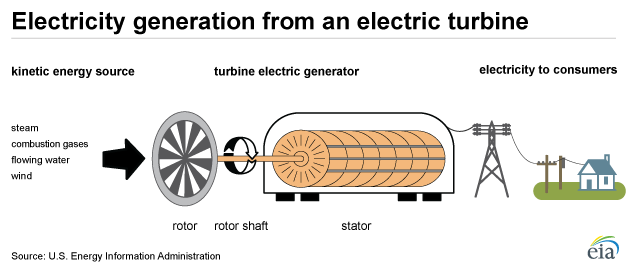How electricity is generated – An electric generator is a device that converts a form of energy into electricity. There are many different types of electricity generators. Most electricity generation is from generators that are based on scientist Michael Faraday’s discovery in 1831. He found that moving a magnet inside a coil of wire makes (induces) an electric current flow through the wire. He made the first electricity generator, called a Faraday disk . which operates on the relationship between magnetism and electricity and led to the design of the electromagnetic generators we use today.
Turbine driven generators
Most U.S. and world electricity generation is from electric power plants that use a turbine to drive electricity generators. In a turbine generator, a moving fluid—water, steam, combustion gases, or air—pushes a series of blades mounted on a rotor shaft. The force of the fluid on the blades spins (rotates) the rotor shaft of a generator. The generator, in turn, converts the mechanical (kinetic) energy of the rotor to electrical energy. Different types of turbines include steam turbines, combustion (gas) turbines, hydroelectric turbines, and wind turbines. How electricity is generated

Steam turbines are used to generate most of the world’s electricity, and they accounted for about 42% of U.S. electricity generation in 2022. Most steam turbines have a boiler where fuel is burned to produce hot water and steam in a heat exchanger, and the steam powers a turbine that drives a generator. Nuclear power reactors use nuclear fuel rods to produce steam. Solar thermal power plants and most geothermal power plants use steam turbines. Most of the largest U.S. electric power plants use steam turbines.
Combustion gas turbines, which are similar to jet engines, burn gaseous or liquid fuels to produce hot gases to turn the blades in the turbine.
- Steam and combustion turbines can be operated as stand-alone generators in a single cycle or combined in a sequential, combined cycle. Combined-cycle systems use combustion gases from one turbine to generate more electricity in another turbine. Most combined-cycle systems have separate generators for each turbine. In single-shaft combined-cycle systems, both turbines may drive a single generator. In 2022, combined-cycle power plants supplied about 34% of U.S. net electricity generation.
- Combined-heat-and-power plants (CHP) and cogenerators, use the heat that is not directly converted to electricity in a steam turbine, combustion turbine, or an internal-combustion-engine generator for industrial process heat or for space and water heating. Most of the largest CHP plants in the United States are at industrial facilities, such as pulp and paper mills, but they are also used at many colleges, universities, and government facilities. CHP and combined-cycle power plants are among the most efficient ways to convert a combustible fuel into useful energy.
- Hydroelectric turbines use the force of moving water to spin turbine blades to power a generator. Most hydroelectric power plants use water stored in a reservoir or diverted from a river or stream. These conventional hydroelectric power plants accounted for about 6% of U.S. electricity generation in 2022. Pumped-storage hydropower plants use the same types of hydro turbines that conventional hydropower plants use, but they are considered energy storage systems. Other types of hydroelectric turbines called hydrokinetic turbines are used in tidal power and wave power systems. (How electricity is generated)
- Wind turbines use the power in wind to move the blades of a rotor to power a generator. There are two general types of wind turbines: horizontal axis (the most common) and vertical-axis turbines. Wind turbines were the source of about 10% of U.S. electricity generation in 2022.
Ocean thermal energy conversion (OTEC) systems use a temperature difference between ocean water at different depths to power a turbine to produce electricity.
Other types of generators (How electricity is generated)
How electricity is generated – Many different types of electricity generators do not use turbines to generate electricity. The most common in use today are solar photovoltaic (PV) systems and internal-combustion engines.
Solar photovoltaic cells convert sunlight directly into electricity. These cells may be used to power devices as small as wrist watches, or they can be connected to form modules (or panels). Modules are connected in arrays that power individual homes or form large power plants. Photovoltaic power plants are now one of the fastest-growing sources of electricity generation around the world. In the United States, PV power plants were the source of about 3% of total utility-scale electricity generation in 2022.
How electricity is generated – Internal-combustion engines, such as diesel engines, are used all around the world for electricity generation, including in many remote villages in Alaska. They are also widely used for mobile power supply at construction sites and for emergency or backup power supply for buildings and power plants. Diesel-engine generators can use a variety of fuels, including petroleum diesel, biomass-based liquid fuels and biogas, natural gas, and propane. Small internal-combustion-engine generators fueled with gasoline, natural gas, or propane are commonly used by construction crews and tradespeople and for emergency power supply for homes.
Other types of electricity generators include fuel cells, Stirling engines (used in solar thermal parabolic-dish generators), and thermoelectric generators.
How electricity is generated-Energy storage systems for electricity generation include hydro-pumped storage, compressed-air storage, electrochemical batters, and flywheels. These energy storage systems use electricity to charge a storage facility or device, and the amount of electricity they can supply is less than the amount they use for charging. Therefore, the net electricity generation from storage systems is counted as negative in EIA reports (Electric Power Monthly and Electric Power Annual) to avoid double counting electricity use for charging the storage system..
NEXT POST – What is Money
